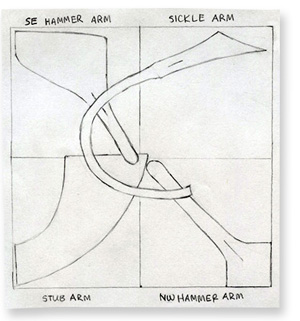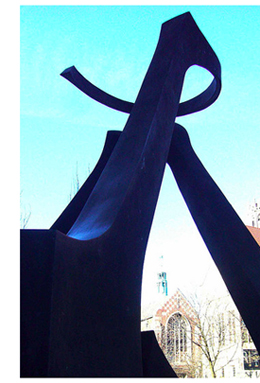| Sun | Mon | Tue | Wed | Thu | Fri | Sat |
|---|---|---|---|---|---|---|
| 1 | 2 | 3 | 4 | 5 | ||
| 6 | 7 | 8 | 9 | 10 | 11 | 12 |
| 13 | 14 | 15 | 16 | 17 | 18 | 19 |
| 20 | 21 | 22 | 23 | 24 | 25 | 26 |
| 27 | 28 | 29 | 30 | 31 |
CATEGORIES
RECENT ENTRIES
BLOG ROLL
The May Day myth
No, Dialogo doesn't cast a hammer and sickle shadow on May 1—or on any other day of the year.
By Benjamin Recchie, AB'03
 As part of this year's Scav Hunt item #277, a kind of Scav-within-Scav (pdf) designed to set the world record for biggest scavenger hunt, contestants were asked to find which building on the quads has a Ferrari out front. It was a trick question, of course: the building is Albert Pick Hall for International Studies, and the "Ferrari" is not an exotic sports car but the 1971 statue Dialogo, by then-University artist in residence and professor of art Virginio Ferrari. As a generation of U of C tour guides have pointed out, Dialogo is the abstract sculpture surreptitiously designed to cast a shadow of a hammer and sickle, the international symbol of communism, on Pick's east wall on May 1—a kind of leftist finger in the eye to the University's famously capitalistic Economics Department. It's a compelling and much-retold story, the only problem being that it is not true.
As part of this year's Scav Hunt item #277, a kind of Scav-within-Scav (pdf) designed to set the world record for biggest scavenger hunt, contestants were asked to find which building on the quads has a Ferrari out front. It was a trick question, of course: the building is Albert Pick Hall for International Studies, and the "Ferrari" is not an exotic sports car but the 1971 statue Dialogo, by then-University artist in residence and professor of art Virginio Ferrari. As a generation of U of C tour guides have pointed out, Dialogo is the abstract sculpture surreptitiously designed to cast a shadow of a hammer and sickle, the international symbol of communism, on Pick's east wall on May 1—a kind of leftist finger in the eye to the University's famously capitalistic Economics Department. It's a compelling and much-retold story, the only problem being that it is not true.
The debunker of this myth is Will Vaughan, a fourth-year in the College, president of the Ryerson Astronomical Society, and self-described sundial enthusiast. Vaughan has long been suspicious of the hammer-and-sickle story. "The sun's altitude at noon changes very slightly from day to day, even near the equinoxes, so Dialogo's shadow should still resemble a hammer and sickle on April 30 or May 2," he point out. Also, the sun in the same place in the sky at noon twice a year. Since May 1 is 52 days before the summer solstice, the sun would shine at the same angle 52 days after the solstice as well. Thus, he says, "Dialogo should cast the same shadow at noon on August 14 as it does at noon on May 1." There's also the question of what "noon" is. Is it 12:00 local time, or is it solar noon, when the sun is at its highest point in the sky (which is at 12:48 PM on May 1)? Finally, he says, he saw the shadow for himself: "The sickle's OK, but the hammer's not right at all!"
 While proving that the statue didn't cast such a shadow in practice may have been good enough at some universities, Vaughan decided (in true UChicago fashion) to prove it couldn't work in theory, either. First, he built a simple model of the statue in Google Sketchup, then verified its accuracy by simulating its shadow for May 1 and comparing that to his observations. He started building a more detailed model "when I realized that the geometry of the sculpture ruled out the possibility of its shadow ever looking much like the Communist hammer and sickle."
While proving that the statue didn't cast such a shadow in practice may have been good enough at some universities, Vaughan decided (in true UChicago fashion) to prove it couldn't work in theory, either. First, he built a simple model of the statue in Google Sketchup, then verified its accuracy by simulating its shadow for May 1 and comparing that to his observations. He started building a more detailed model "when I realized that the geometry of the sculpture ruled out the possibility of its shadow ever looking much like the Communist hammer and sickle."
"There are three problems with the shadow," Vaughan says. "The sickle curves too much at its end, the hammer's handle crosses the sickle too close to the sickle's handle, and the hammer doesn't really look like a hammer. The third problem is the important one—the geometry of the hammer arms of Dialogo makes it impossible for these arms to cast a more hammer-like shadow." Instead of a hammer and sickle, the shadow resembles...well, I'm not sure what, exactly. (A sickle and two crossed golf clubs? "Duffers of the world, unite! You have nothing to lose but your bogies!")
Vaughan says that if Ferrari had really wanted the shadow to resemble a hammer and sickle, all he would have had to do was swap the short element on the northeast corner of the sculpture with the tall hammer-like one on the northwest corner. He has helpfully provided a more detailed explanation with diagrams (PDF).
If you're still not convinced by Vaughan's research, then maybe you'll believe the words of the artist himself. In the May/June 1971 University of Chicago Magazine, Ferrari says:
"What I want to call to mind in this sculpture are the four corners of the world. Three of the four forms emerge from strong, geometric elements, representing the diversity, pain, and depression in the life on any continent. They rise up slowly and become soft and delicate; two of the forms almost touch in the center in a caressing manner. The third, almost a circle, hovers over the two, to suggest protection and security for the life of tomorrow. The fourth form represents a big wave, symbolic of the water that surrounds and unites all the continents."
As for the rumor that the sculpture scared the Economics Department out of the new Pick Hall, Vaughan debunked that, too. With the help of the University of Chicago Library's Special Collections, he determined that the Economics Department was never based in Pick Hall, and never planned to move there. In any case, stressing the unity of the four corners of the world doesn't seem as Marxist as it does internationalist, which makes sense when you realize that the building's namesake, Albert Pick Jr., was the former chairman of the Chicago Council on Foreign Relations. So much for that.
May 18, 2011
